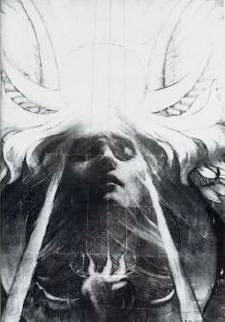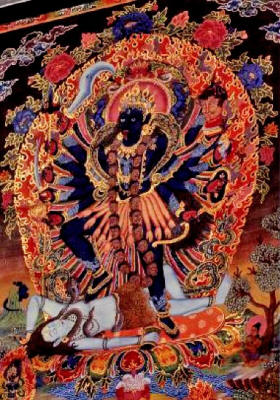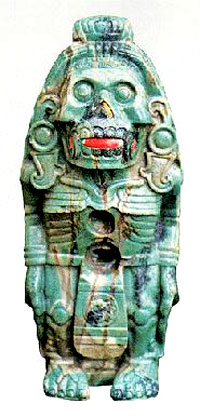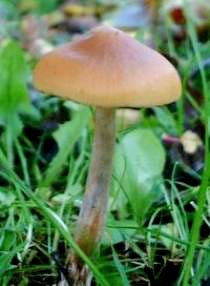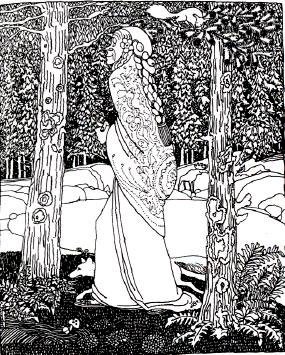|
by John Lash
Andalucía February 2007 from MetaHistory Website
One thing they are not is fashionable, unless you count the occasional personal fetish such as the spiffy mesh tie worn by the gentleman pictured above.
But shamanism, let's face it, is pretty fashionable these days. It is the height of trendiness in some circles. The craze has been building for quite a while.
Peter Furst's Flesh of the Gods (published in 1972, right on the far node of the 1972 - 2012 interval) set the standard for anthropological studies that made hallucinogens legitimate, finally overthrowing Eliade's opinion (reconsidered at the end of his life) that the use of psychoactive plants belongs to the decadent phase of shamanism.
Since Furst, shamanism has become the central subject of anthropology as well as the sacred pastime of the drug culture.
And
beyond the counterculture, it has engendered pop obsessions
including everything from
ayahuasca tourism to communal drumming in
the park.
Shamanism was the radical chic of the 1990s, and coming into the 21th century it seems to be holding strong, but could this be a sunset phenomenon? Do I risk sounding extremely perverse (once again) by posing such a question?
Let me qualify: Could it be that
the present ubiquity of the phenomenon - with everybody and his
cousin now claiming to be a shaman - might give way to something at
once more discreet and more demanding, a shamanic order that does
not announce itself as such? This would be the party of Xolotl. In
the spirit of magical realism, I will write of the party as if it
already exists.
Think of the tribes as trees, great many-branched and many-rooted wonders, leafed with countless expressions of personalized creativity and steadied by massive trunks of communal solidarity.
The five families of tribal trees,
...represent the emergent human community of the end-time.
Then the hidden shamanic order, the party of wily and elusive crypto-shamans, would be the bone-white angel-hair mesh of underground mycelium in mycorrhizal relationship with the family trees.
Wasson (in Soma: Divine Mushroom of Immortality):
How convenient that someone noticed.
This adage, attributed to Jesus, may be one of merely three lines in the New Testament that reflect some genuine Gnostic insight.
The other two would be,
All three lines play on the same theme:
I have argued extensively that the gnostikoi of the Pagan Mysteries were kundalini adepts.
They did not control the serpent power - no one does - but allowed themselves to be supple channels for it. They mastered its effects by achieving states of steady concentration free of hallucinations.
This type of concentration, achieved while standing with eyes open, is requisite for observing the Organic Light. One effect of this sublime encounter is a sense of exquisite tenderness, infinite softness, for the luminosity of Sophia's primary substance body is soft.
The Organic Light has a texture
comparable to marshmallow. (I originally considered calling it the
Mallow Light, and do call it so in certain writings on Gaian
biophysics.)
This is the norm in some Gnostic writings, and the same sense occurs in Plato. What is ultimately true is Reality itself. Only Truth is real.
Beholding the Organic Light, "ye shall know the truth, and the
truth shall set you free," because in the omnipresent soft
luminosity you see the Suchness, the primordial Void that is
Shunyata, not emptiness but a fullness, a self-radiant plenum in
which the truth of every possible thought, emotion, and perception
reaches pure and paramount ripeness, and reaches it, and reaches
it....
The Organic Light is rich in content: a well of living information, a fountainhead of boundless, self-articulating intelligence. Asian traditions call the realization it affords sabija samadhi, "perfect concentration with seed," contrasted to nirbija samadhi, "concentration without seed."
In
The Seeker's
Handbook (1991), I explained that the first is knowing nothing
through knowing everything, and the second is knowing everything
through knowing nothing. It's fun to have options..
There is a harlequin aspect to the dog-headed end-time guides, although some of them are somber, prone to dress in black and wear silver and coral ornaments, like Silvio Manuel.
Some of them sit modestly aside, grinning in the dark. Xolotl is dog-headed because in occult jargon that animal represents clairaudience, hearing in the canine frequencies.
The party of Xolotl have various occult faculties, but most notably the capacity to hear subvocally - hear and transmit.
Jean Delville's drawing of Parsifal was done around 1885 at the height of the Occult Revival in Europe.
Delville was associated with the "20" and the Rose + Croix, artistic movements permeated with esotericism. In this above stylized image, he depicts the secret of the dog-headed clairaudience:
Delville wanted to depict Parsifal as the example of the trained initiate able to send and receive clairvoyantly and clairaudiently.
He could as well have been representing one of Xolotl's crew.
The
serpent current in the spine bends like a fiddlehead fern into a
three-forked knot of warm fire in the soma chakra, a psychosomatic
center beneath the heart, known only to siddhas and excluded from
the usual model of the chakras. Delville represents it symbolically
by the Hebrew letter Shin, "divine fire."
But to know these wizards intimately is to touch the secret candor (warmth) they embody, inflected in sexual flair and erotic finesse. The serpents of wisdom move among the end-time tribes like - well, like soft, feathery serpents. They slither among categories and terms, evading and subverting cultural codes and memes, but they are clear and explicit in their syntax.
Their muse
is language itself, the consummate whore and ultimate shapeshifter.
Consider the way Kali is depicted in her role of Tripurasundari, destroyer of the three worlds at the end of Kali Yuga, when civilization goes down in fire and flood:
This is a mythic image of anesthetic shock, the kind that comes over humanity as it faces extinction by natural catastrophes, as well as by psychological catastrophes, the breakdown of ordinary life, the shattering of paradigms, the loss of all expectations, the immolation of faith, and the end of all hope.
Today we are on the verge of witnessing a collective manifestation of what Stan Grof calls "spiritual emergencies."
His recent book, When the Impossible Happens, presents a vivid inventory of such emergencies.
Newari style thanka,
Katmandu, 1999
In an unparalleled career spanning fifty years, commencing with clinical observation of thousands of LSD sessions, including his own, Grof has shown that traumatic experiences normally dismissed as due to "mental breakdown" or "mental illness" are actually opportunities to break through into non-ordinary reality and acquire paranormal perception.
The 2012 end-time marks a global pandemic of such opportunities.
It signals a world gone mad, with millions of crazed and helpless people stunned by the loss of their habits of living and terrified on a daily basis by the scale and severity of geophysical changes.
Imagine the look of dumbfounded horror on the faces of people helplessly caught in catastrophic geophyical changes such as the sudden rise of sea levels, earthquakes, and violent storms:
The red mouth recalls the bloody grin of Kali. The head is a skull, like the face of a shaman who turns magically into a skeleton, and the elaborate ears suggest the dog-like powers of hypertonicity.
On his torso, Xolotl has a kind of armor-plating, an insectoid or armadillo belly, but there are two round holes (for burning incense) in the place of the soma chakra and the solar plexus:
Yet this horrendous trauma has another face, as Grof has taught for so many years:
When ordinary reality
crumbles before our eyes, non-ordinary reality dawns...
Aztec statuary depicts the two deities Quetzalcoatl
and Xolotl back to back, joined into a single, Janus-faced entity.
As the world humans have made comes apart in
convulsions of fire and flood, a world will arise anew, but first
within human perception, because seeing the Next World comes with
traumatic extrapolation of the senses toward non-ordinary reality,
in the very moment we behold the destruction of the existing world.
It entails a total planetary makeover in parallel with a visionary awakening and plunge into altered states and paranormal perception, a shift into evolutional anomaly and shamanic magic.
The scale of natural law
will be reversed: instead of survival depending upon everyone's
conformity to consensus reality, it will depend on some individuals
entering and navigating the realms of non-ordinary reality.
Archeologists estimate
that these extensive paintings range from 22,000-9,000 BCE,
indicating that a good deal of this artistic activity (thought to be
closely related to shamanic visionary states) occurred while some
groups of hardy folk were living through the last Ice Age.
This discovery proved that cave painting in more remote times was, both in technique and representation, more evolved than the art that survived from the close of the Paleolithic Era.
It suggests that access to non-ordinary perception, including shamanic rapport with animal powers ubiquitously depicted in those caves, and the gender balance suggested by erotic markings and goddess effigies, declined from a peak that may be identified temporally as the crisis point of extinction going into the last Ice Age.
In other words, the few survivors of the last minor extinction event were traumatized into altered states of perception and entered non-ordinary reality in ways that allowed them to survive by magical-shamanic practices, evident in the art of these caves.
They survived by practical skills, of course, but I would argue that their practical skills were, for the most part, acquired magically.
Learning from the
animals how to live, choose food, find water, learning from the moon
and stars how to formally order their activities and transmit their
generational experience in long-term narratives, and so forth - are
not abilities that can be gained through trial and error alone. They
require, and reflect, magical enhancement.
This may be a good question to
ponder throughout the 2012 end-time.
But these skills declined slowly over many millennia, and split apart. Hence early Neolithic cave relics and rock art are markedly inferior to what preceded them in the Paleolithic. We did not evolve from grunting, hairy cave people who hacked out stone implements: we evolved from handicapped cave people who themselves were degenerate heirs of far more skilled, sophisticated primitives.
And these skilled, sophisticated primitives were themselves the diaspora of civilizations destroyed by a combination of natural and human-made factors.
The mark of such
civilizations was high attainment of social order and technological
accomplishment at the expense of the dissociation of the magical and
practical faculties which, working together, comprise the dual
psychosomatic endowment of the human species.
As we come forward in history, paranormal perception and altered states of cognition are not only dismissed by science (although previously they engendered science) and rejected by religion (although previously they informed religion), they are deemed anathema in society worldwide, if not dismissed as pure silliness.
Ask the party of Xolotl.
They will say this:
See the dumbfounded terror of
what's to come, when millions of people realize they cannot face the
makeover of the planet because they have denied those very faculties
that would equip them for "spiritual emergencies" of the magnitude
now beginning to overtake us.
Gaia exhibits the same law of mercy throughout the animal kingdom where, for instance, the gazelle brought down by the cheetah does not suffer the horror of being eaten alive, but undergoes a shift of consciousness and bodily sensation due to specific chemicals released by the mortal strike, the lethal bite, chemicals that activate a trance state of blissful anesthesia.
We have all seen
this happen with cats and mice, with the mouse clearly in an altered
state. Humans who have survived attacks by lions, tigers, and
grizzlies report how they are plunged into a semi-comatose state of
bliss. They do not feel the pain of being mauled to near-death, but
are caught up in a state of ecstatic anesthesia.
Shiva is also the autochthonous god of the wilderness, long worshipped by hunters and shamanic tribes in Dravidia, Southern India, the land of the sacred cobra. Shiva is the honored deity of siddha yoga, the tradition in which Stan and Christina Grof were intimately involved for many years. Lord Shiva is the master of animal powers and the patron saint of those who acquire paranormal faculties, siddhis.
His sleeping form represents
the "general anesthesia" of humanity, yes, but also the occult or
sleeping powers of the self-selecting few who will face the end-time
with heightened perception, empowered by a magical intention to
survive.
Poor Carlitos.
Idolized by millions, his books published in twenty languages, his adventures the inspiration for a huge cult movement lasting over 30 years, Castaneda saw his secrecy violated, his personal history smeared in the face of the general public, his human foibles exposed, and his writings dismissed as phony shamanism, the invention of a schizophrenic poseur.
Yet no matter what you may think of Castaneda, the magic he sowed in our minds is real.
Poor Carlitos was in the party of Xolotl, a creative genius
and genuine end-time seer.
I am astounded that no one has yet made this observation.
Magical realism is the genre of fiction, mainly from Central and South America, associated with names such as Miguel Angel Asturias, Gabriel Garcia Marquez, and Julio Cortazar, but equally so with European writers such as Hermann Hesse and Italo Calvino. (I exclude the sophomoric mysticism of Brazilian Paolo Coehlo, an obvious stooge of the Catholic Church disguised in Sufi wool.)
Castaneda would not, I think, be unhappy among this company, where he certainly deserves a place.
The
incomparable genius of Castaneda lies in how he got so many of us
involved in his feat of magical realism, as participants and not
merely readers, and how his fiction (if such it was) included so
much shamanic lore that is durable, testable, and veracious.
It is not merely a literary genre, it is an occult medium for narrative entrainment. In the hands of able tricksters, the "master narrative" is not a totalitarian scheme with closure, but a grounding and framing device, an heuristic and hermeneutic tool of immense suppleness.
The members of the party are deeply versed in literature and literary trends. Adepts of lucid syntax, they are well-read, critically and eclectically minded alchemists of the Word, like Dale Pendell.
Magic realism is their natural mode of discourse. Probably the inceptive work in this genre was Don Quixote by Cervantes. Or was it Don Quixolotl?
Anyway, this novel, generally taken to be
disenchanting satire of chivalry, was written right after the
Conquest of Mexico, and there is a significant parallel here. Allow
me to elaborate.
Their arrival in central Mexico
around 1250 is one of the more enigmatic events in world history.
Something weird happened when this scruffy, bellicose tribe marched
into the Valley of the Moon and overthrew Toltec civilization, only
to be overthrown themselves less than 300 years later, at which
point in time they were annihilating themselves due to ritual
ingestion of toxic doses of the royal addiction, chocolotl; hence
their aberrant and psychotic behavior.
The party of Xolotl is the outgrowth of the underground dissemination of the lost Toltec wisdom, raised to a higher octave and transplanted into the present by a retrograde magic operating from the future.
This is how the Toltec adepts, past masters of serpent wisdom in MesoAmerica, worked out their survival - their transmigration in time, if you will. An elaborate technique, to say the least.
But the
old sorcerers were exceedingly intricate in their ways, as don Juan
astutely noted.
Curiously, Melville is not usually included in the school of magical realism, but he surely ought to be. He may be regarded as the patron saint of the party in literary terms. Mardi is a flawed masterpiece of magical realism in which Melville tried to channel some erotic projections mixed with end-time visions set in Oceania.
The
spiritual crisis he underwent while writing Moby Dick is typical of
the "spiritual emergencies" recounted by Grof. In Melville's intense
psychological trauma, undergone in hermetic solitude, we can see the
birth pangs of the party of Xolotl that now move among the end-time
tribes in America.
Imagine a line of dancers in a kundalini conga. Don Juan said this was the form of the Plumed Serpent that allowed the party to transit as a unit to the other side.
To some minds, this image will suggest dematerialization, recalling the claim of Arguelles that in the 2012 end-time some people attuned to the right frequencies of awareness could be swept into another dimension on a cosmic beam emanating from the center of the galaxy.
But is this literary image of Castaneda compatible with
such a literal notion of off-planet transport?
As a mythological motif, the fall of the Goddess is unique and cannot be associated with "the fall of humanity," a notion refuted in Sethian Gnosticism.
Since humanity does not fall from a divine state, there is no need to return to the divine source. Pagan, non- and pre-Christian Gnosis set the aim of realizing divinity here and now on earth, in the realm of the senses, by a direct encounter with the indwelling goddess, Sophia.
Wisdom is her name, diversity is her game, and novelty is the key to the importance of humanity in Her Dreaming, the imagination of the earth.
Escape from the planet by
dematerialization or miraculous transport is not the option here,
but knowing first hand the presence of the Nahual in this world
always is.
The nahual, non-capitalized, is the member of the party of Xolotl who on any occasion points to the Unknown, sees it first, divines its effects, or otherwise indicates its presence to the party. (In Pagan Mysteries at Eleusis and elsewhere, the nahual was called the hierophant.)
This person is immediately recognized by the others as the nahual for that occasion.
Sometimes the nahual is identified by
the oracle of rubbed charcoal. The sound of small cubes of burnt
wood grated together gently in the palm signals the hypertonic
hearing that points, like a hunting dog, to the looming presence of
the Nahual.
Castaneda
carefully made this distinction between the Unknown and the
Unknowable, explaining that the former is inexhaustible, there being
always infinitely more to know, but we cannot even know if the
Unknowable is infinite or finite! (Vedanta and Kashmiri Shaivism
make similar distinctions.)
Even a momentary glimpse of it bestows eternal youth and ineffable wisdom:
So is the Grail described in Arthurian legend (Parzival, Ch. 9).
The Organic Light is a wellspring of healing power. In the 2012 end-time and after, Gaia will heal herself with catastrophic changes, but many other miraculous healings will occur as the geophysical shift unfolds.
The traditional depiction of Krishna with blue skin points to this mystical experience. The 2012 end-time may portend sightings of Blue Person on an unprecedented scale.
The Nahual associated with the Organic Light is a place one can look into, and go into if you have the adequate stealth, but some entities, including human beings or humanoid forms such as Blue Person, inhabit it permanently.
Among these are the Maya Blue Face, a tight clan of diviners and healers who continually "make the rounds" to the galactic center and back.
They are the Lords of Palenque, allies of P. azurescens, the most potent of psilocybin mushrooms (above). Azura: blue face.
They are the Asuras of
Hindu-Persian mythology, traditionally portrayed as fearsome
sorcerers and gorgon-like monsters to veil their true identity and
protect their benevolent mission from snoops and sidewinders.
Their faces show the profile of local royalty depicted in the murals of the Classical Maya: sloped forehead, oval eyes, wide rounded nose like a fat slice of melon, long ears. Most distinctively, they bear on their cheeks the teardrop marking of the highest shamanic skill, predation, which is also the source of the deepest healing of which humans are capable.
Blue Face shamans are warriors gifted with lethal and baffling abilities, powers for killing and torture, and flesh-eating savvy. They acquired the supreme skill through a millennial pact with the great predator cats, the jaguar and puma, who also have teardrop markings.
Linda Tucker discovered the same symbiotic link between prey and predator among the White Lions of Timbavati.
The Zulu Lion shaman Credo Mutwa explained the link to her, connecting the lion to celestial patterns. The connection is pan-terrestrial, but the Maya Blue Face are special agents of the periodic return to the celestial center.
They know the spidery
tracks to the galactic core and out again into the spiraling arms.
The Blue Face shamans do not enact predation, but they use the feline savvy of the great predatory species to guide and heal whomever they encounter on their rounds.
Emanating the deliciously feral presence of the big
hunting cats, they are benign and serene, the time-honored elders of
the party of Xolotl.
Geophysically, it seems to have kicked off in Asia, in Iran, Thailand and Sumatra. But the Western world, the Americas, is the place where it will be dramatically defined.
There the younger generation are already deeply involved in the next evolutionary breakthrough, because the ground for a forward leap has been prepared in the Americas by the party of Xolotl since the 13th Century when the Toltec adepts went underground.
Many members of the
five end-time tribes have party connections. The work of Xolotl
adepts depends on their reception by the tribes. They are not
self-proclaimed prophets, but sly masters of divination. Not guides,
but guardians of the directive gnosis. Not messiahs, but no-nonsense
mystics as able to navigate the apocalypse as to row a canoe.
Kali's apocalyptic
dance represents the catastrophic situation to which the party of
Xolotl will apply their occult skills, but in a highly selective
manner. There are only two responses to extinction: anesthetic
denial or sudden awakening of non-ordinary states. The face of
Xolotl mirrors both to us, as explained above.
It contains no prophecy or speculation, but presents a rich inventory of non-ordinary experience:
Grof writes:
Precisely so:
To Grof's impressive inventory I would add ISP (infrasensory perception) and bilocation (often attained or anticipated in lucid dreaming), involving the plasmic double.
The hilarious antics of don Genaro illustrate some of the wilder possibilities of bilocation for cosmic clowning.
Grof's account of
his bilocation ("Temptations in a Non-Local Universe: Failed
Experiment in Astral Projection") provides sobering and cautionary
insight into the pitfalls and aberrations of this most occult of
occult phenomena.
She is capable of resurrecting any species - on evidence for this claim, investigate the Cambrian explosion - and the Maya Blue Face are uniquely complicit in how she does so.
In the NDE people are drawn into a tunnel of the Organic Light via a particular channel that leads to the Treasury of Lights described in the non-NHL (Nag Hammadi Library) Gnostic texts, the Books of Jeu and the Pistis Sophia.
Some will go the entire route and expire, others will return,
endowed with transmigratory secrets. Such secrets cannot be applied
without intimate parallel knowledge of nature, especially
reproduction in the plant kingdom and cultivation of fungal spores.
(Amanita witch with her animal familiar, a fox.)
They are in a literal sense people who preserve and disseminate seeds, like Dominique Guillet, founder of Seeds of Kokopelli.
In another sense,
the shishta carry forward in time the seeds of culture, mainly
symbolic systems, math, music, and languages, insuring their
continuity through the precarious passage of extinction.
These vital young warrior-lovers are the
beneficiaries of magic and initiation in the end-time, the spiritual
offspring of impeccable parents, dreamers and stalkers in the party
of Xolotl.
|


